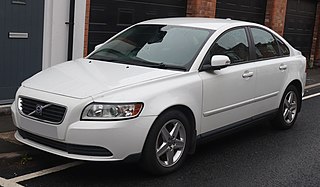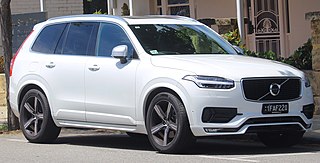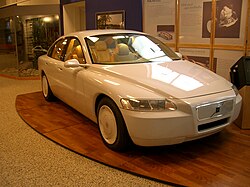
A hybrid vehicle is one that uses two or more distinct types of power, such as submarines that use diesel when surfaced and batteries when submerged. Other means to store energy include pressurized fluid in hydraulic hybrids.

Volvo Cars is a Swedish multinational manufacturer of luxury vehicles headquartered in Torslanda, Gothenburg. The company manufactures SUVs, station wagons, and sedans. The company's main marketing arguments are safety and its Swedish heritage and design.

The Volvo S60 series is a compact executive car manufactured and marketed by Volvo since 2000.

The Volvo XC60 is a compact luxury crossover SUV manufactured and marketed by Swedish automaker Volvo Cars since 2008.

The Volvo C30 is a three-door, front-engine, front-wheel-drive premium compact hatchback, manufactured and marketed by Volvo Cars from 2006 to 2013, in a single generation. Powered by inline-four and straight-five engines, the C30 is a variant of the Volvo S40/V50/C70 range, sharing the same Ford C1/Volvo P1 platform. Volvo marketed the C30 as a premium hatchback / sports coupe.

A zero-emission vehicle, or ZEV, is a vehicle that does not emit exhaust gas or other pollutants from the onboard source of power. The California definition also adds that this includes under any and all possible operational modes and conditions. This is because under cold-start conditions for example, internal combustion engines tend to produce the maximum amount of pollutants. In a number of countries and states, transport is cited as the main source of greenhouse gases (GHG) and other pollutants. The desire to reduce this is thus politically strong.

The Volvo S40 is a series of compact and Subcompact executive car marketed and produced by the Swedish manufacturer Volvo Cars from 1995 to 2012, offered as a more mainstream alternative to the compact executive Volvo S60 to compete in a lower pricing bracket. The S40 was more or less positioned against premium-leaning small family cars like the Volkswagen Jetta as well as some mass-market large family cars.

The Volvo XC90 is a mid-size luxury crossover SUV manufactured and marketed by Volvo Cars since 2002 and now in its second generation.

The Volvo S90 is an executive sedan manufactured and marketed by Swedish automaker Volvo Cars since 2016. Its estate variant is called the Volvo V90.

A green vehicle, clean vehicle, eco-friendly vehicle or environmentally friendly vehicle is a road motor vehicle that produces less harmful impacts to the environment than comparable conventional internal combustion engine vehicles running on gasoline or diesel, or one that uses certain alternative fuels. Presently, in some countries the term is used for any vehicle complying or surpassing the more stringent European emission standards, or California's zero-emissions vehicle standards, or the low-carbon fuel standards enacted in several countries.

A plug-in hybrid electric vehicle (PHEV) is a hybrid electric vehicle whose battery pack can be recharged by plugging a charging cable into an external electric power source, in addition to internally by its on-board internal combustion engine-powered generator. Most PHEVs are passenger cars, but there are also PHEV versions of sports cars, commercial vehicles and vans, utility trucks, buses, trains, motorcycles, mopeds, and even military vehicles.
Hybrid vehicle drivetrains transmit power to the driving wheels for hybrid vehicles. A hybrid vehicle has multiple forms of motive power.

An alternative fuel vehicle is a motor vehicle that runs on alternative fuel rather than traditional petroleum fuels. The term also refers to any technology powering an engine that does not solely involve petroleum. Because of a combination of factors, such as environmental concerns, high oil-prices and the potential for peak oil, development of cleaner alternative fuels and advanced power systems for vehicles has become a high priority for many governments and vehicle manufacturers around the world.
Volvo Cars Recharge is the overarching range name for all cars by Volvo with any form of electric charging system, including both fully electric and plug in hybrid powertrains. The Recharge nameplate appears on the rear-side columns of the cars in the same way as the Momentum, R Design, and Inscription trim ranges are marked.

An electrically assisted turbocharger (EAT) is an arrangement where an electric motor assists the gas-driven turbocharger in providing forced induction, particular at times when exhaust gas flow is insufficient to produce the desired boost. Some systems integrate the motor inside a turbocharger, while others use a separate electric supercharger.

The Volvo V60 is a compact estate produced by Volvo Cars related to the S60. The vehicle was first released in autumn 2010, facelifted in 2014, and is in its second generation since 2018.

The Jaguar C-X75 is a hybrid-electric, 2-seat, concept car produced by British automobile manufacturer Jaguar Cars in partnership with the derivative of the Formula One team, Williams Advanced Engineering, which debuted at the 2010 Paris Motor Show. The powertrain of the C-X75 concept is rated at 778 hp through four YASA electric motors, each of which drives one of the four wheels. The batteries driving these motors are recharged using two diesel-fed micro gas turbines instead of a conventional four-stroke engine. It was described as a design study that would influence future design and technology.
The Volvo P80 platform was a Swedish mid-size unibody automobile platform developed and produced by Volvo Cars. It was in use from 1991 to 2005. It is designed for different wheelbases in front-wheel drive configurations and was adapted to all wheel drive. It debuted with the 1991 Volvo 850. Although heavily modified by TWR, the same basic chassis was used as the underpinnings for the C70. After the model year 2000 most P80 models were replaced by their P2 successors, with the exception of the C70 convertible which remained in production until 2005. A total of 1,360,522 cars based on this platform were built.

The Volvo Engine Architecture (VEA) is a family of straight-three and straight-four automobile petrol and diesel engines produced by Volvo Cars in Skövde, Sweden, since 2013, Zhangjiakou, China since 2016 and Tanjung Malim, Malaysia since 2022 by Proton. Volvo markets all engines under the Drive–E designation, while Geely groups the three-cylinder variants with its other engines under the G-power name. These engines are some of the few ever put into production as twincharged engines, in the company of the Lancia Delta Integrale and concept Jaguar CX-75.

The Volvo XC40 is a subcompact luxury crossover SUV manufactured by Volvo Cars. It was unveiled on 21 September 2017 as the smallest SUV model from Volvo, below the XC60. Orders started in September 2017, and manufacturing began in November 2017. It was introduced with conventional petrol and diesel engines, with a plug-in hybrid model being introduced in 2019, and a battery electric vehicle model was released in 2020 as the XC40 Recharge. A version of the battery electric model with a sloping rear roof was released in 2021 as the C40 Recharge.


















